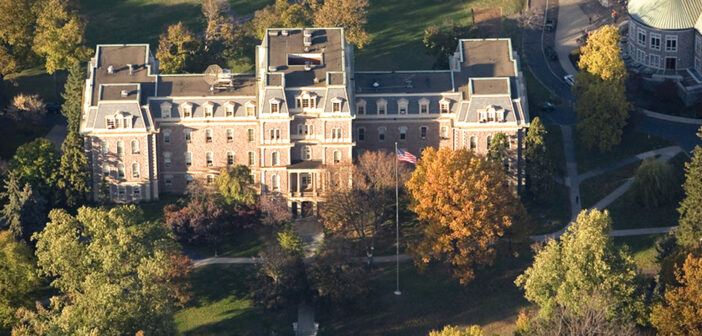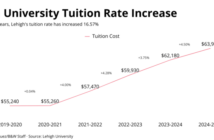While Lehigh University, Lafayette College, Muhlenberg College and Moravian College are all smaller colleges in size located no more than 20 miles from each other in the Lehigh Valley, how they are going about reopening their campuses during the fall 2020 semester is vastly different.
All of these schools originally hoped to welcome all undergraduate students back in the fall, but only Moravian is following through with this plan, offering in-person, hybrid, and remote classes to its students. Lehigh and Muhlenberg are allowing first-years and a limited number of upperclassmen who need to come back on campus, while offering in-person, hybrid, and remote classes. Lafayette is only allowing students who need to be on campus to come, and all classes are fully remote.
“One thing that this situation has taught us is that it is important to be able to adjust as the conditions change,” said Provost Nathan Urban.
Urban explained the major setback in welcoming everybody back to Lehigh happened in late July and early August when the school’s task forces realized that it would be best to only have six people to a bathroom and one person to a room within the residence halls.
Urban said Lehigh would never have allowed a student with COVID to sleep in the same room as another student.
Another key factor in Lehigh’s final decision was the potential impact on the surrounding city of Bethlehem. Lehigh’s undergraduate student body is over 5,000 students.
“Our student population makes up a significant fraction of the people in Bethlehem,” Urban said. Bethlehem is home to about 75,000 residents.
Urban explained that the majority of students at Lehigh would likely be resilient to COVID-19, whereas the older and lower income residents of Bethlehem may not be.
Between the factors of dorm space and the safety of Bethlehem, Lehigh concluded that it could not allow everybody back to campus.
Lehigh felt comfortable housing select students who need access to campus, as well as first-years to live in residence halls after they secured access to testing.
“We [wanted]to introduce students to each other and to Lehigh… We knew that a lot of juniors and seniors would be living off campus anyway,” Urban said.
Muhlenberg College came to the same conclusion as Lehigh to welcome back first-year students and select upperclassmen by focusing on capacity of dining and housing, testing availability and turnaround time, and its mission as a small liberal arts college.
“We wanted to reduce the number of students on campus so we wouldn’t be overburdening our healthcare systems, the Allentown Health Bureau, or the local testing needs, and to make sure we could manage student behavior and make sure the community would be healthy and safe for students, faculty, and staff,” said Allison Gulati, dean of students at Muhlenberg College.
For these reasons coupled with their capacity constraints in their dining hall and residence halls, preparedness for online teaching and COVID-19 spikes across the country, Muhlenberg concluded that it would only be letting 750 students back on campus. Of these 750 students, Muhlenberg would bring back their full first year class in person, as well as 200 upperclass students who needed to be on campus for research, employment, or financial or personal hardship.
“There are decades of research in higher education that the first six to eight weeks of a students’ college career is what really creates the most opportunity for success over the four years,” Gulati said. “How students start, most often dictates how they end up…we know that things like social belonging, building important peer relationships that give you the support that you need, and starting to acclimate to the academic environment and to meeting faculty and staff..is most critical. It made sense for us to prioritize first-year students right now.”
Moravian College focused on other pressing factors when they decided how to reopen, such as demographics, culture of their school, and mental health of their students. Capacity was not an issue for their student population of 2,500.
“The majority of our students come from the Lehigh Valley and the surrounding areas,” said Moravian President Bryon Grigsby. “My statement is that I think you’d rather have me have them controlled on campus monitoring their health… than you would having them off campus. You don’t know what anyone is doing in their own home.”
Grigsby felt that bringing those who want to come back to campus is necessary.
“Forty percent of our students are first generation college students,” he said. “These are not kids who are able to have a gap year because their parents are wealthy enough to be able to make that happen. These are kids who are scrounging together every dime to go to college, and it just may be easier not to go to college if you miss a year. We thought if we missed a year, we could lose a generation.”
Grigsby said a significant portion of Moravian’s undergraduate population would be safer at Moravian than at home. He said around 500 students are homeless, live in unsafe environments or have parents who are elderly or immunocompromised. For many Moravian students, living on campus is their best option.
He said so far, students have been cooperative in following protocols related to COVID-19.
“The moment the upperclassmen came back to join the first years on campus after orientation, everything clicked into place,” Grigsby said.
Grigsby said students may request a single dorm room, however, he feels it is important to Moravian College that students are able to live in doubles to protect their mental health.
Students living in doubles will be subjected to quarantine as a “family unit.”
“I’m just so proud of the students because they’re all wearing their mask. I see them when they’re alone even wearing their mask outside — they don’t want to lose what they got right now,” Grigsby said.
Unlike Lehigh’s robust off-campus student population and Moravian’s largely local population, Lafayette considered the fact that it is a 95 percent residential campus that has over 2,600 students from all over the United States and the world.
Making the decision of only allowing special permission for a student to be on campus was made with COVID testing response time, the student experience, and population density of Lafayette’s campus in mind.
“If there’s a sign of an outbreak, we need to know it early,” said Lafayette Provost John Meier. “Folks in the college age group can be asymptomatic and still be spreading it, but other people at Lafayette College like me would probably be very symptomatic.”
Meier added that dorming the entire campus, although Lafayette is somewhat similar in size to Moravian, was out of the question because of crowded living quarters.
Meier said Lafayette did not want to welcome first-year students to campus, because it is not fair to the first-year student to start off college with these circumstances.
“[Not allowing first-years on campus] was one of the hardest things… the big part was knowing we knew we were going to have to teach classes remotely, and it did not seem like a great first semester experience to say, ‘Come be in a dorm, stay in isolation for the first two weeks, and take all of your classes remotely, even though you’re on campus,’” Meier said.
As of publication there are reportedly zero known COVID-19 cases among students living on Lehigh’s campus, and four positive off-campus cases. Moravian College reports two positive cases. Muhlenberg is reporting one positive case.






Comment policy
Comments posted to The Brown and White website are reviewed by a moderator before being approved. Incendiary speech or harassing language, including comments targeted at individuals, may be deemed unacceptable and not published. Spam and other soliciting will also be declined.
The Brown and White also reserves the right to not publish entirely anonymous comments.